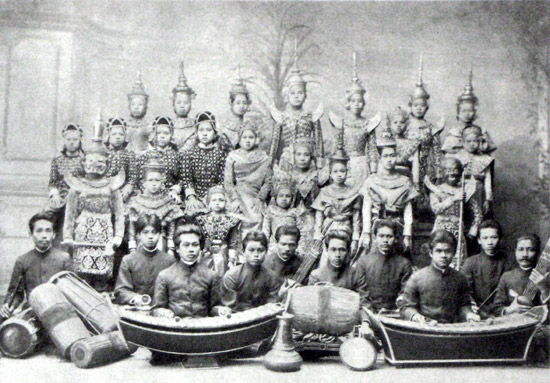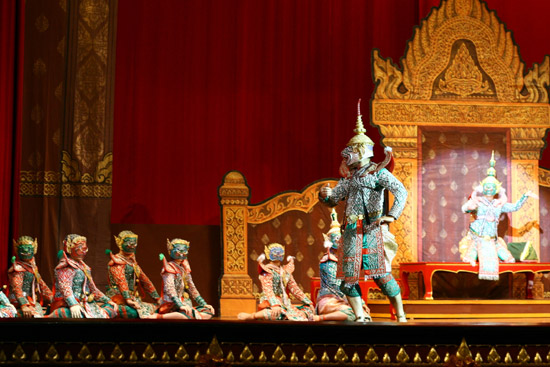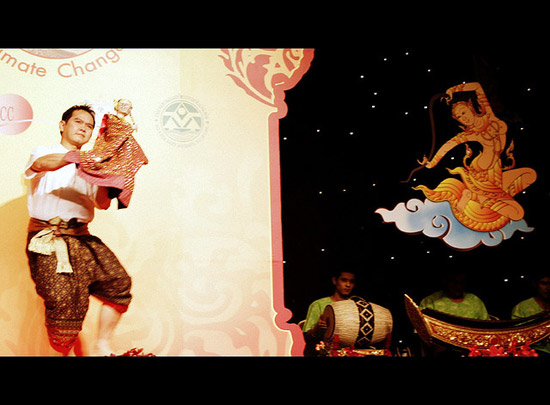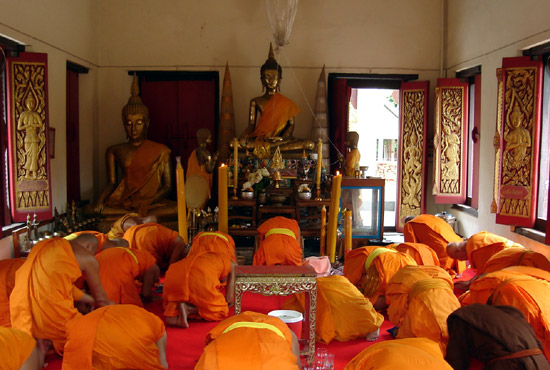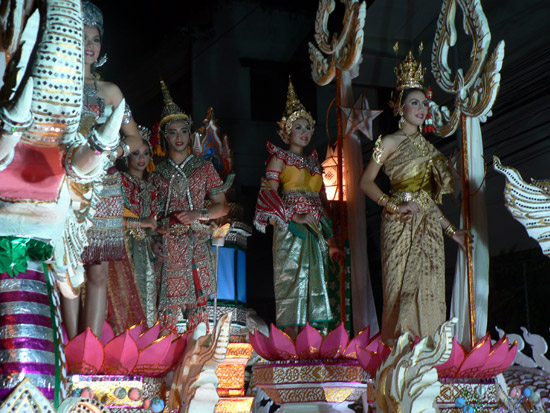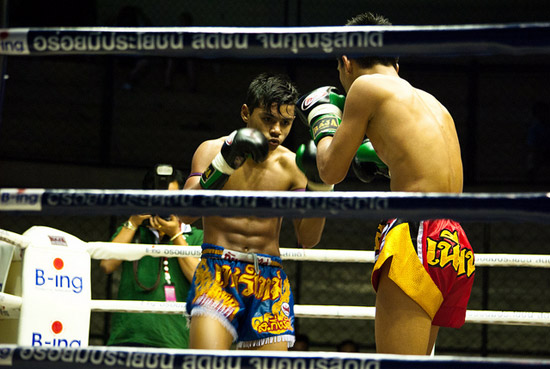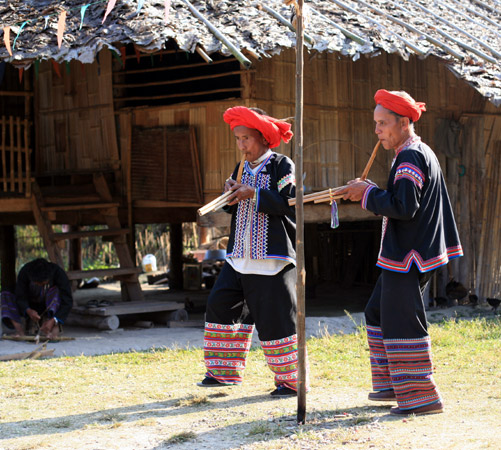Music: Traditional Forms
Court Music
Piphat
In Thailand, classical music often refers to the refined ensemble forms historically performed in the royal courts. One such form is piphat, an ensemble featuring wind and percussion instruments. It is considered the primary form of Thai classical tradition, functioning in both sacred and secular music, such as the Buddhist invocation entitled sathukan, or the suites called phleng rueang. It is also used to accompany traditional Thai theatrical and dance forms, including khon, lakhon (classical dance), and nang (shadow puppet theater).
Piphat mai khaeng, the most common piphat configuration, features the pi (a type of high-pitched oboe) accompanied by xylophones, gong circles, and percussion instruments. A similar configuration is used in another ensemble, piphat mai nuam, features a flute (khlui phiang) instead of the high-pitched pi. Both types of piphat ensemble may include a two-stringed bowed instrument called saw u. Piphat ensembles also vary in size. Piphat khrueang ha is the smallest piphat ensemble and is comprised of six instruments: pi nai (oboe), ranat (xylophone), khong yong wai (gong circle), taphon (drum), glong thad (barrel drums), and ching (small cymbals). Piphat khrueang khu is a slightly larger eight-member ensemble, and the largest ensemble is the 10-member piphat khrueang yai.
Wong khrueang sai is a classical ensemble that features string instruments, typically bowed lutes and zithers. Two-stringed bowed lutes—one high register and one low register (saw duang and saw u, respectively)—the three-stringed zither (jahke), a flute (khlui), the hammered dulcimer (khim), hand drums, and cymbals are the standard configuration.
Mahori
Mahori is a form of Thai and Cambodian classical vocal ensemble traditionally played by women in the courts of Central Thailand and Cambodia. It combines the xylophones and gong circles of the piphat with the strings of the khruang sai ensemble. The three-string bowed lute, or saw sam sai, is the principal vocal accompanist in the mahori and gives this type of Thai ensemble its unique sound.
Classical Dance
Piphat ensembles accompany classical dance for the royal court, and Khon is one such form of dramatic dance. It is performed by men in ornamented, papier-mâché masks and glittering costumes resembling demons, gods, or mythological figures. A piphat ensemble and a narrator accompany what many regard as the most stylized form of Thai dance. Female dancers are featured in a similar version of this subgenre of classical Thai dance called khon phu ying.
Lakhon Nai
Lakhon nai is another dance originating in the Thai royal court. It features female dancers in a slow choreography accompanied by a piphat ensemble, enacted with epic poems such as that of Inao (known in Java as Panji). A variation of this genre with male performers is called lakhon nai phu chai.
Fawn Thai
Fawn thai originated in northern Thailand. It was invented and taught by Chiang Mai dance master Chao Dararasami. After its inception, provincial fawn Thai styles came into practice, each flavored by the unique musical style of the province—fawn-ngiew from Chiang Rai, with Burmese-influenced music and costume design being one such example.
Shadow Puppet Theater
There are two types of the nang: nang talung and nang yai. Nang talung is performed with intricately patterned buffalo-hide or cowhide puppets that are about 50 centimeters (20 in) tall. They usually possess a movable, jointed arm controlled by a string.
Nang yai means "big puppet," and these performances use large, decorated scenes, and characters measuring as much as two meters (7 ft) tall. Unlike the nang talung, the yai puppets lack arm joints, but performance themes and styles are similar.
Nang yai is traditionally presented outdoors in central village spaces (often for festivals), in front of large white screens that are held on each side by bamboo or wood poles. A bonfire behind the screen—or, in modern times, electric light—projects the shadows of the puppets. A piphat ensemble provides the musical accompaniment, usually playing pieces from the na phat “sacred suite” repertoire, considered capable of summoning gods and spirits.
Religious Music
Thailand is a primarily (95 percent) Buddhist country, and Buddhism is an integral part of the culture, as evidenced by numerous temples (wats) and the active engagement of Buddhist laypeople, monks, and nuns in community life. The Theravada Buddhism practiced in Thailand and other parts of Southeast Asia entails sutra chanting, typically in the original Pali, the language in which the earliest Buddhist teachings were compiled. The chants—believed to calm and invigorate the body and mind, and remind the chanter of the essential teachings of the tradition—are a fundamental aspect of monastic training and are considered auspicious for those within hearing.
Chants can be intoned by a solo monk or devotee, but are more commonly recited by a group of monks or nuns, both in the context of daily monastic activity and for important community ceremonies such as funerals and major shared endeavors (such as dedicating a new school). Common chants include the Ti Sarana (Triple Refuge), the Panca Sila (Five Precepts), and Buddha Vandana (Salutations to the Buddha).
Folk Music
Pleng phua bahn encompasses folk styles from all regions of Thailand, and stands in contrast to Thai classical repertoires. Examples include the New Year’s dances of the northern Hill Tribes; the verbal sparring and teasing of mor lam glawn singing in the Lao-speaking Isan region; and the Muslim vocal music of likay wolou in the south. The northeastern pong lang (or phonglang) is an up-tempo dance music, its name derived from a wooden xylophone that is vertically attached to a tree. Originally the music was played on a related instrument called kroh lor, which was used by farmers to scare birds away from the fields. Pong lang is an ancient music that, like some other indigenous forms of the region, long predates the Sukhothai period, and predates even Indian influence in Thai culture.
Thai Country Music
Pleng luk thung (“songs of children of the fields”), more commonly called luk thung, is a form of “country” music. It is one of the most popular styles in Thailand, with slow-tempo songs typically expressing the struggles and sorrows of everyday life among the rural poor. Singers employ an expressive vibrato singing style that somewhat resembles the yodeling found in American country music, in performances that blend pleng phuan bahn, central Thai classical music, and elements of Thai folk dances. The form developed in the first half of the 20th century, when it was known as pleng talat (market songs); the term luk thung was first used in the 1960s.
Musical Theater
Likay is a dance theater form often performed at village festivals, with elaborately costumed singers and dancers in a sort of musical variety show that incorporates satire and dramatic skits as well as songs and dance routines. Thai likay shares much with luk thung, including some of the same repertoire and performance styles; there are also similarities with the Khmer theater style called yike.
Temple Festivals
The ngan wat, or temple festival, is traditionally the major event in towns throughout Thailand: seasonal festivals are celebrated with a veritable carnival that takes place over a week or so on the grounds of a wat, with rides and carnival games as well as nightly performances of luk thung, likay, mor lam, and other folk and pop forms, as well as chanting, piphat, and nang theater performances. Still a regular part of Thai culture (and these days typically highly amplified), temple festivals now have more competition from other forms of entertainment. But they show no sign of disappearing.
Boxing Music
Muay Thai—Thai boxing, the national martial art—is performed in a ritualized setting, with the combatants each stepping through elaborately choreographed “offering” dances to honor their teachers (and give a preview of some of their moves). A key part of the match itself is the music (pi muay, or simply “boxing music”), which is played to heighten the intensity of the match, rhythmically pulsing and droning to make sure the excitement reaches its proper peaks. The shrill wailing of the pi is the dominant sound in these ensembles, which are rounded out by the percussive klong kaak drums, ching bells, and khong mong gongs.
Music of Isan
Mor Lam
Isan, in northeast Thailand and separated from Laos by the Mekong River, is home to a Lao-speaking population ethnically closer to the Lao Lum (Lowland Lao) of that country than to the majority ethnic groups of central Thailand. The relatively recent political border has caused some divergence of styles, but the mor lam of Isan remains closely akin to Lao lam music.
Traditionally, mor lam songs are interpretations of Laotian glawn poems accompanied primarily by the khaen (the national instrument of Laos), a free-reed mouth organ with a sound that resembles the harmonica or accordion. Contemporary forms are characterized by strong rhythmic accompaniment and a conversational style that has been compared to rap and hip-hop. Many types of lam and mor lam (for example, northern Lao khap and lam gon and lam phuen in Isan) were traditionally played with only the khaen in accompaniment—by a duo of singer and khaen player or, often, by a solo musician/storyteller who would alternate between verses and instrumental cadenzas—but larger ensembles have become the norm, particularly in Thai Isan. Most commercial artists now use at least some electric instruments, typically in a pop-band arrangement with the addition of khaen and sometimes khuy (bamboo flute). Phin (three-stringed lute) and jakhe are sometimes used as well.
Kantrum
In southern Isan, near the Cambodian border, an uptempo dance music known as kantrum gets people on their feet. Propelled by a pair of kantrum drums and a pair of sko drums, as well as ching bells, krab (wooden sticks), and the tro (a two-string fiddle much like the saw u), the traditional version features a singer or pair of singers in Khmer or Thai. The interplay between singers and tro is similar to that of singer and khaen in traditional morlam, with the instrumentalist playing behind and between the lyrics.
Article written for World Trade Press by Matthew Monte.
Copyright © 1993—2025 World Trade Press. All rights reserved.

 Thailand
Thailand 